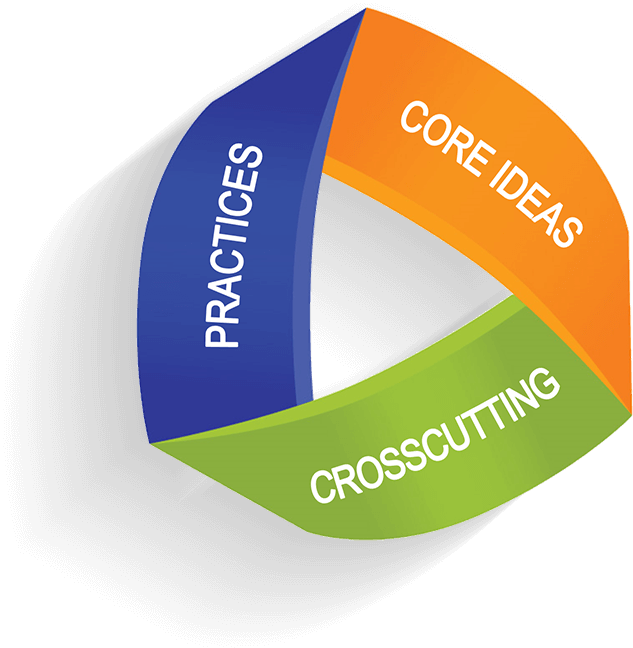THE THREE DIMENSIONS OF SCIENCE LEARNING
Within the Next Generation Science Standards (NGSS), there are three distinct and equally important dimensions to learning science. These dimensions are combined to form each standard—or performance expectation—and each dimension works with the other two to help students build a cohesive understanding of science over time.

Crosscutting Concepts help students explore connections across the four domains of science, including Physical Science, Life Science, Earth and Space Science, and Engineering Design.
When these concepts, such as “cause and effect”, are made explicit for students, they can help students develop a coherent and scientifically-based view of the world around them.
Science and Engineering Practices describe what scientists do to investigate the natural world and what engineers do to design and build systems. The practices better explain and extend what is meant by “inquiry” in science and the range of cognitive, social, and physical practices that it requires. Students engage in practices to build, deepen, and apply their knowledge of core ideas and crosscutting concepts.
Disciplinary Core Ideas (DCIs) are the key ideas in science that have broad importance within or across multiple science or engineering disciplines. These core ideas build on each other as students progress through grade levels and are grouped into the following four domains: Physical Science, Life Science, Earth and Space Science, and Engineering.
GET TO KNOW
The Next Generation Science Standards (NGSS) are K–12 science content standards. Standards set the expectations for what students should know and be able to do. The NGSS were developed by states to improve science education for all students.
A goal for developing the NGSS was to create a set of research-based, up-to-date K–12 science standards. These standards give local educators the flexibility to design classroom learning experiences that stimulate students’ interests in science and prepares them for college, careers, and citizenship.
Introduction

QUALITY NGSS INSTRUCTIONAL UNITS

RUBRIC FOR LESSONS AND UNITS

MIDDLE AND HIGH SCHOOL COURSE MAPPING

EVIDENCE STATEMENTS
IMPLEMENT
The NGSS call for a three-dimensional approach to K–12 science instruction. This represents a significant transition from previous state standards. That’s why effective implementation demands a great deal of collaboration and patience among states, districts, schools, teachers, and students.
Thoughtful and coordinated approaches to implementation will enable educators to inspire future generations of scientifically literate students. That is the vision of the NGSS. This website provides a range of high-quality resources that empower educators, administrators, parents, and the general public to help bring this vision to life.

ECONOMIC INNOVATION DEPENDS ON A BROAD FOUNDATION OF MATH AND SCIENCE LEARNING

SCIENCE STANDARDS PREVIOUSLY UNCHANGED SINCE EARLY 1980S

RIGOROUS DEVELOPMENT PROCESS LED BY STATE PARTNERS

SUPPORTED BY BUSINESSES, SCIENTISTS, EDUCATORS, AND THE PUBLIC
WHY
Science—and therefore science education—is central to the lives of all Americans.
A high-quality science education means that students will develop an in-depth understanding of content and develop key skills—communication, collaboration, inquiry, problem solving, and flexibility—that will serve them throughout their educational and professional lives.

